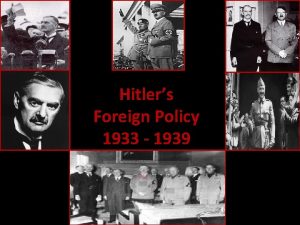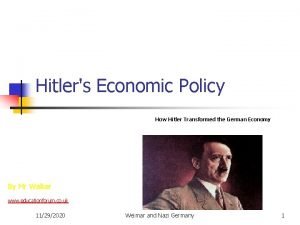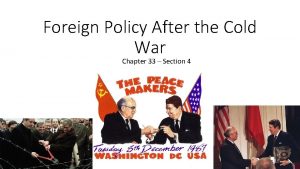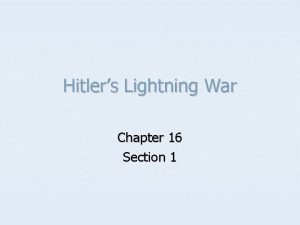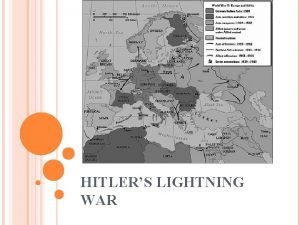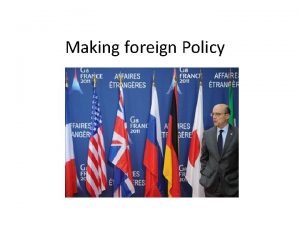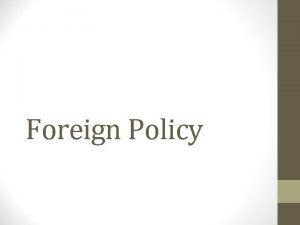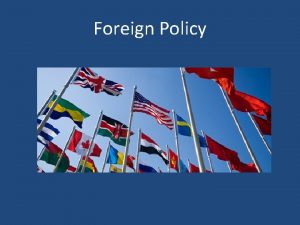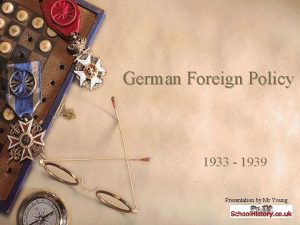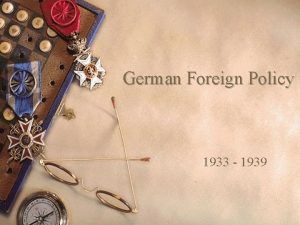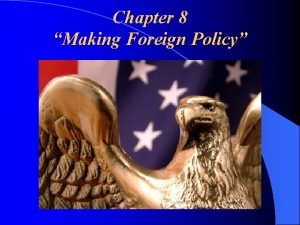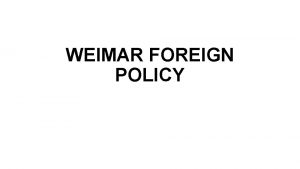Hitlers Foreign Policy timeline 1933 1939 After seizing












- Slides: 12

Hitler’s Foreign Policy timeline 1933 - 1939 After seizing power in Germany, Hitler set in place an ambitious foreign policy that aimed to undo the effects of the Treaty of Versailles. Hitler wanted to: - re-take control of the territories that it had lost at Versailles, such as the Rhineland - re-arm its military forces - something forbidden by the Treaty of Versailles - expand its borders to provide Lebensraum (living space) for its population - unite all the German-speaking people of Europe under the control of Nazi Germany Hitler was prepared to gamble that the other European powers would be reluctant to go to war to stop him.


Recovery of the Saar area – 1935 In 1935, Hitler's plans to strengthen Germany and undermine the Treaty of Versailles were given a boost when the German-speaking Saar region voted to reunite with Germany. The region, important for coal production, had previously been removed from German control as a term of Versailles to weaken Germany industrially. When the leading European nations did not react to this violation of Versailles, Hitler was encouraged to see how far he could go in breaking other terms of Versailles. Rearmament 1935 (official) In 1933, Hitler ordered his army generals to prepare to treble the size of the army to 300, 000 men. He ordered the Air Ministry to plan to build 1, 000 war planes. Military buildings such as barracks were built. He withdrew from the Geneva Disarmament Conference when the French refused to accept his plan that the French should disarm to the level of the Germans or that the Germans should re-arm to the level of the French. Either way, the two main powers of Europe would be balanced. Hitler knew that the French would not accept his plan and therefore when he withdrew from the conference, he was seen by some as the politician who had a more realistic approach to foreign policy and the French were seen as the nation that had caused Nazi Germany to withdraw. For two years, the German military expanded in secret. By March 1935, Hitler felt strong enough to go public on Nazi Germany’s military expansion – which broke the terms of the Versailles Treaty. Europe learned that the Nazis had 2, 500 war planes in its Luftwaffe and an army of 300, 000 men in its Wehrmacht. Hitler felt confident enough to publicly announce that there would be compulsory military conscription in Nazi Germany and that the army would be increased to 550, 000 men.

Franco-Soviet Treaty of Mutual Assistance – Feb 1936 France & USSR agreed on a mutual defence pact which was clearly aimed at Nazi Germany but which did not specifically mention her. Both countries recognised the threat to their own borders, regional stability and post-WW 1 national boundaries caused by the rise of Nazi Germany. France & the USSR recognised the potential deterrent to future potential German expansionism by the geographical fact that they surrounded Germany and could threaten a war on two fronts for Berlin just as they had done in alliance before WW 1. Hitler often referred to it as the ‘Russian Pact’ France made it clear to the USSR that in the event of an attack she would have to get the agreement/support of Britain, Belgium, etc as signatories of the Locarno treaties (1925) to be able to act aggressively against Germany. Hitler who was gambling with European reactions to his actions in Europe decided to be publicly outraged by this ‘threat’ to Germany and called France’s bluff in the following month by marching their troops into the demilitarised Rhineland Zone. He was also aware of a public division of opinion in both the UK and France as how to react to German demands for the recovery of lost territories due to the Treaty of Versailles, etc.

Recovery of the Rhineland De-militarized zone (March 1936) For many years the Rhineland area had been a key industrial region of Germany, producing coal, steel and iron resources. The Rhineland also formed a natural barrier to its neighbour and rival, France. In the event of a war, the River Rhine, if properly defended, would be a difficult obstacle for an invading force to cross. One of the terms of the Treaty of Versailles was that the Germans would not be able to keep military forces in a 50 km stretch of the Rhineland. Hitler resented this term as it made Germany vulnerable to invasion. He was determined to enlarge his military capability and strengthen his borders. Under the terms of Versailles, the Rhineland had been made into a demilitarised zone. Germany had political control of this area, but she was not allowed to put any troops into it. Therefore, many Germans concluded that they did not actually fully control the area despite it being in Germany itself. In March 1936, Hitler took what for him was a huge gamble – he ordered that his troops should openly re-enter the Rhineland thus breaking the terms of Versailles once again. He did order his generals that the military should retreat out of the Rhineland if the French showed the slightest hint of making a military stand against him. This did not occur. Over 32, 000 soldiers and armed policemen crossed into the Rhineland Why didn’t the Allies (Britain and France) do anything about this violation of the Versailles Treaty ? France was going through an internal political crisis at the time and there was no political leadership to concentrate against Nazi Germany. Britain generally supported the view that Nazi Germany was only going into her own “backyard” and that this section of Versailles was not needed to be enforced in the mid-1930’s. It was believed that Germany was behaving in a reasonable and understandable manner.

Rome-Berlin Axis – 1936 Rome-Berlin Axis, Coalition formed in 1936 between Italy and Germany. An agreement formulated by Italy’s foreign minister Galeazzo Ciano informally linking the two fascist countries was reached on October 25, 1936. Hossbach Memorandum – Nov 1937 The Hossbach Memorandum was written by Friedrich Hossbach, Adolf Hitler’s adjutant. In November 1937 Hitler held a highly secret meeting, known as the Hossbach Conference, at the Reich Chancellery to discuss Nazi Germany’s future. Some believe that the Hossbach Memorandum clearly indicates that Hitler wanted war so that he could get for Germany the living space in Eastern Europe he believed that Nazi Germany needed. Others believe that the document is too vague to give a clear indication of Hitler’s plans despite the use of words such as “attacker" when referring to Nazi Germany. The Hossbach Memorandum was used by the Allies at the Nuremberg Trials in their efforts to prove that certain senior Nazis actively planned for war and ‘Lebensraum’.

Operation Green – Nazi expansion into Czechoslovakia - 1937 ‘It is my unalterable decision to smash Czechoslovakia by military action in the near future. It is the business of the political leadership to await or bring about the suitable moment from a political and military point of view. An unavoidable development of events within Czechoslovakia, or other political events in Europe providing a suddenly favourable opportunity which may never recur, may cause me to take early action. The proper choice and determined exploitation of a favourable moment is the surest guarantee of success. To this end preparations are to be made immediately. ’ [Adolf Hitler] ‘“When Germany has achieved complete preparedness for war, then the military conditions will have been created for carrying out an offensive against Czechoslovakia, so that the solution of the German problem of Lebensraum [Living Space] can be carried to a victorious conclusion. (In certain circumstances, Operation Green might begin before the completion of Germany’s full military preparations for war. ) The military objective of Operation Green is still the speedy occupation of Bohemia and Moravia with the simultaneous solution of the Austrian question in the sense of incorporating Austria into the German Reich. ” [General Jodl]

Anschluss – the unification of Germany & Austria – March 1938 Hitler wanted all German-speaking nations in Europe to be a part of Germany. To this end, he had designs on re-uniting Germany with his native homeland, Austria. Under the terms of the Treaty of Versailles, however, Germany and Austria were forbidden to be unified. Hitler also wanted control of the largely German-speaking area within Czechoslovakia, called the Sudetenland. Importantly, Austria shared a border with this area. In an attempt to realise his goals, Hitler was determined to destabilise Austria and undermine its independence. His ultimate goal was anschluss (union) with Austria. The failed coup The Austrian Chancellor, Dollfuss, tried to crack down on the Socialists and Nazis - political factions that he thought were tearing the country apart. Dollfuss banned the Nazi party. In 1934, Hitler ordered the Austrian Nazis to create havoc in Austria. This turned into an attempt to overthrow the government. Chancellor Dollfuss was murdered but the attempted coup failed because the Austrian military intervened to back up the government. In 1934, Italy had an agreement with Austria that it would protect Austria from outside aggression. The Italian dictator, Mussolini, honoured the agreement and moved Italian troops to the Austrian border to deter Hitler from invading. Events in Austria The new Austrian Chancellor, Schuschnigg tried to preserve the country from German invasion by trying not to give Hitler an excuse for aggression. He tried to co-operate with Hitler as much as possible. Schuschnigg signed the German-Austrian Agreement of 1936. This pact recognised the independence of Austria but the price was that Austria's foreign policy had to be consistent with Germany's. The agreement also allowed Nazis to hold official posts in Austria. Schuschnigg hoped this would appease Hitler. He was wrong. Schuschnigg's position was undermined in 1936 when Hitler and Mussolini formalised the Rome-Berlin Axis during their joint involvement in the Spanish Civil War (1936 -39). With Germany and Italy now firm allies, Austria had lost the protection of Italy and was vulnerable to German attack.

Anschluss – the unification of Germany & Austria – Cont/d In 1938 Schuschnigg visited Hitler at his summer retreat at Berchtesgaden, near the Austrian border. Hitler demanded that Nazis be given key government posts in Austria. Schuschnigg compromised and the Nazi member, Seyss-Inquart, was made Minister of the Interior. Hitler ordered Austrian Nazis to create as much trouble and destruction as possible in order to put pressure on Schuschnigg. If Hitler could claim that Austrian law and order had broken down he could justify marching German troops into Vienna to restore peace - despite the fact that he was responsible for the chaos in the first place. ‘Four days in March’ Wednesday 9 th March 1938 On the 9 March 1938, in a desperate act, Schuschnigg announced a referendum whereby the Austrian people would decide for themselves if they wanted to be a part of Hitler's Germany. Hitler was furious. If the Austrians voted against joining Germany his excuse for invasion would be ruined. Thursday 10 th March 1938 Hitler told his generals to prepare for the invasion of Austria. He ordered Schuschnigg to call off the referendum. Knowing he would receive no help from Italy, and that France and Britain would not interfere in Hitler's plans, Schuschnigg conceded. He called off the referendum and resigned. The Nazi Austrian Interior Minister, Seyss-Inquart, was ordered by Hitler to ask for German help in restoring order in Austria. Friday 11 th March 1938 Hitler reassured Czechoslovakia that they had nothing to fear. Saturday 12 th March 1938 German troops marched into Austria unopposed. Hitler now had control of Austria. A month later, Hitler held a rigged referendum. The results showed that the Austrian people approved of German control of their country.

Munich Conference – Sep/Oct 1938 In 1938, Hitler turned his attention to the Sudeten area of Czechoslovakia. The nation of Czechoslovakia had been created after WWI. Two Slavic peoples, the Czechs and the Slovaks, came together to form the country along with three million German speakers from the Sudeten area on the border with Germany, and smaller numbers of Hungarians, Ukrainians and Poles. The 20 years since its creation had seen its democracy and economy flourish. The main threat to the fledgling nation was from Hitler's plans for expansion and from the Sudeten Germans who, used to being part of the German-speaking Austrian empire, were not happy at their inclusion in a Slav-controlled state. By March 1938, Hitler had successfully invaded Austria without a shot being fired. With one major German-speaking territory under his control he then turned his attention to another - the Sudeten area of Czechoslovakia. Hitler wanted to use the Sudeten Germans to create trouble in Czechoslovakia and, as he had in the Rhineland Austria, use this as a pretence for invading and "restoring order". Not content with merely one piece of Czechoslovakia, Hitler planned to smash the country. The Czechs and Slovaks were of Slavic origin and, according to Hitler's racial proclamations that the German/Aryan people were superior to other races, they were considered Untermenschen (subhuman).

The meetings over Sudetenland - 15 September 1938, Neville Chamberlain met Hitler at his summer retreat on the Austrian border, Berchtesgaden. With German invasion of Czechoslovakia looking imminent and a future European war a very real possibility, Chamberlain agreed in principle that Hitler could claim the Sudetenland without reprisal from Britain. On his return to Britain, Chamberlain managed to persuade his Cabinet and the French (who were allies of the Czechoslovakians) to accept the deal. - 22 September 1938, Chamberlain met Hitler again at Godesberg. With the reluctant agreement of the Czechoslovakian government, Chamberlain offered Hitler control of the Sudetenland. Hitler demanded that the Czechoslovakian army leave the Sudetenland by 1 October. This was a demand designed to provoke the Czechs and provide an excuse for invasion of the whole country. - 29 and 30 of September 1938, representatives of France, Britain, Italy and Germany met at Munich to discuss the Sudetenland problem. Neither the Czechs, nor their allies Russia, were consulted. Hitler traded the promise of peace in Europe for the Sudetenland. The Czechs had to either accept or face the might of the German army alone. They accepted. - Germany entered the Sudetenland on 1 October. Hitler now had control of the Czech fortifications and this would make his next act of aggression much easier. - Hitler and Chamberlain signed a piece of paper promising never to go to war with each other. - Czechoslovakia was further divided when, encouraged by Hitler, Hungary took control of the region of Ruthenia and Poland claimed Teschen. - Czech military effectiveness had been fatally weakened. Britain and France had lost the help of a strong ally for the sake of a few months to rearm their forces. - Russia was offended at being left out and more suspicious of Britain and France.

Danzig issue – 1939 Hitler was determined to overturn the military and territorial provisions of the Versailles treaty and include ethnic Germans in the Reich. In preparation for war with Poland, in the spring of 1939 Hitler demanded the annexation of the Free City of Danzig to Germany and extraterritorial rail access for Germany across the "Polish Corridor, " the Polish frontier to East Prussia. German occupation of Czechoslovakia – March 1939 Britain and France were convinced by the German occupation of Bohemia and Moravia (Czechoslovakia) in March 1939 (in violation of the 1938 Munich Pact) that Hitler could not be trusted to negotiate in good faith. They therefore guaranteed the integrity of Polish territory against German aggression. Germany invaded Poland on September 1, 1939. Britain and France declared war on Germany on September 3. With that, the German invasion of Poland became World War II. German invasion of Poland – 1 Sep 1939 The German Army invaded Poland on 1 September 1939, after Hitler claimed that the Polish had carried out a cross border attack on Germany. On 3 September 1939, Britain and France declared war on Germany and World War Two in Europe had started. Many historians argue that the outbreak of the Second-Sino Japanese War in 1938 was the real outbreak of WW 2. What do you think?
 Hitlers foreign policy
Hitlers foreign policy Hitlers economic policy
Hitlers economic policy Hitler's foreign policy timeline
Hitler's foreign policy timeline Chapter 33 section 4 foreign policy after the cold war
Chapter 33 section 4 foreign policy after the cold war Best practices for seizing electronic evidence
Best practices for seizing electronic evidence Animal kingdom groups
Animal kingdom groups Ddo seizing the dawn
Ddo seizing the dawn After me after me after me
After me after me after me John 14:1
John 14:1 Too foreign for home
Too foreign for home Chapter 32 section 1 hitlers lightning war
Chapter 32 section 1 hitlers lightning war Who were hitlers parents
Who were hitlers parents Hitlers lightning war
Hitlers lightning war
